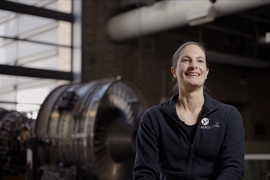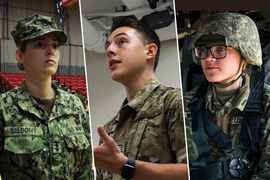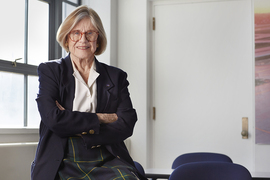Last spring, Liam Gale joined the MIT Office of the Vice Chancellor’s staff in a newly created role to provide services geared for student veterans and their families. As the program administrator for the Student Veteran Success (SVS) office, he helps them navigate the MIT and United States Veterans Affairs landscapes and develops programming to create community among this cohort. Gale knows the student veteran experience firsthand; he served in the U.S. Air Force for eight years before attending the University of Massachusetts at Lowell as an undergraduate. He also holds a master’s degree in social work from Simmons University.
Q: Can you paint a picture of the student veteran population that you serve?
A: It’s a small but diverse population. We have over 100 student veterans at MIT. This is in addition to the community of veterans who are staff, faculty, and instructors, and alumni across all schools and DLCs [departments, labs, and centers]. Some are serving right now in the National Guard, reserves, or are on active duty. And, we have over 100 military families, meaning spouses or children of those in the military, or veterans who are actually studying at MIT.
Many of our student veterans are in graduate programs, mostly MBA students at MIT Sloan. There are just a handful of undergraduates. In fact, I think one of the unique opportunities here at MIT is to figure out how we can increase veterans and active military on the undergrad side, and that's something that I am working on with the admissions office.
Our student veterans come from all branches and career fields in the military, from being a pilot to special operations to administrative. So it’s a wide range of career fields, which gives us a great mix of experiences that students bring to the table.
The diversity of backgrounds and experiences that these veterans bring to the classroom, to the lab, and to research and other academic pursuits, is incredibly valuable. And their ethos of service to the nation jibes perfectly with MIT’s own institutional aspirations.
Q: What is the student veteran experience like, and how is it unique? What kinds of issues do student veterans have to navigate?
A: I can say from my own experience that there is inevitably a little bit of anxiety and uncertainty when you are starting as a student veteran. You’re going into this new environment, and there are a lot of transitions involved in starting school. You’re starting off in a new career, adjusting to civilian life, and separating from the military, which has been your home base for at least several years. Some of our students are undergraduate students coming in after having served for four years. So they are, say, 23 years old, and they haven’t been in a classroom since high school. And now they’re at MIT, where it’s a whole different universe. Graduate student veterans have their own distinct issues to navigate, as they are typically older, are more likely to have families or other close ties, and have been away from a higher education and non-military environment for some time.
Also, it may take some time to make connections and find community, so it’s helpful to meet other student veterans who are going through the same thing. From my own experience, I wasn’t aware of other student veterans in my classes until a few weeks into the semester. So for me that adjustment took a little while but I did find my circle, my network, and that was a good resource for me. I think it gives students a lot of peace of mind to know that there is a group of people — whether it’s maybe a student organization like the Student Veterans Association or my office — that can help them manage and make that transition a little bit smoother.
Q: Your role is new at MIT. Can you explain the kinds of support and resources your office provides and why they are important?
A: Our office provides a range of services, such as helping students coordinate with student financial services, or interfacing with Veterans Affairs. And then there are other processes that student veterans may have to navigate. Some could get activated for deployment or disaster response, which requires taking certain steps like submitting a leave of absence and coordinating with the deans. And then to come back, you have to pause your education benefits. So there are moving parts to all of these scenarios, and we help students work through them.
One of our priorities is trying to increase visibility and recognition on campus for our student veteran population. One example of that is a Veterans Day program we are planning, which will be held on the evening of Nov. 10. MIT observes Veterans Day every year with the assistance of MIT’s ROTC program. But this year we’re planning a larger, more formal event and program, and we are excited to have Secretary of the Massachusetts Department of Veterans Services Cheryl Poppe and U.S.S. Constitution Commanding Officer Billie Farrell joining us. November is also a military family appreciation month, so one idea we are considering is printing out veteran-specific postcards that students can send home, to express appreciation for their families.
These are just a few examples. Since our office is new, our plans and priorities are still evolving. When I first started, I sent out a needs assessment to get a sense from the student veteran community of what kinds of programs and activities they’d like to see. I think a lot of the community would like more camaraderie-building activities, like maybe a river cruise or a sporting event — ways that we can get off campus and meet other veterans. I’m also working with students on professional development workshops and opportunities to engage with outside partners like Home Base at Mass General Hospital, a first-of-its-kind program in the United States that integrates clinical care, education, and research to heal the invisible wounds of war. It’s a great example of a community resource we can access, particularly in terms of mental health and mindfulness practices, that can help with the transition from the military to life as a student veteran.
I believe SVS is going to shift yearly, depending on the student population and what they need. So I plan to conduct surveys at the beginning of each academic year, to really get the pulse of the students and what they want and need.
I have to say, I’m really lucky to be able to partner with, and bounce ideas off of, other offices and programs here at MIT, like the Student Veterans Association and MIT’s Army, Navy, and Air Force ROTC programs. And since one-third of our population are dependents, I also collaborate with Spouses and Partners Connect and the Graduate Families program. All in all, I think SVS is off to a promising start. It’s a really exciting time to be here, because there are so many possibilities, and the work is very rewarding. I am also thankful for the supportive community at MIT; everyone who I have engaged with is determined to make the Institute a better place for our veterans, service members, and military family members.
.jpg?itok=m2fjmgOc)








